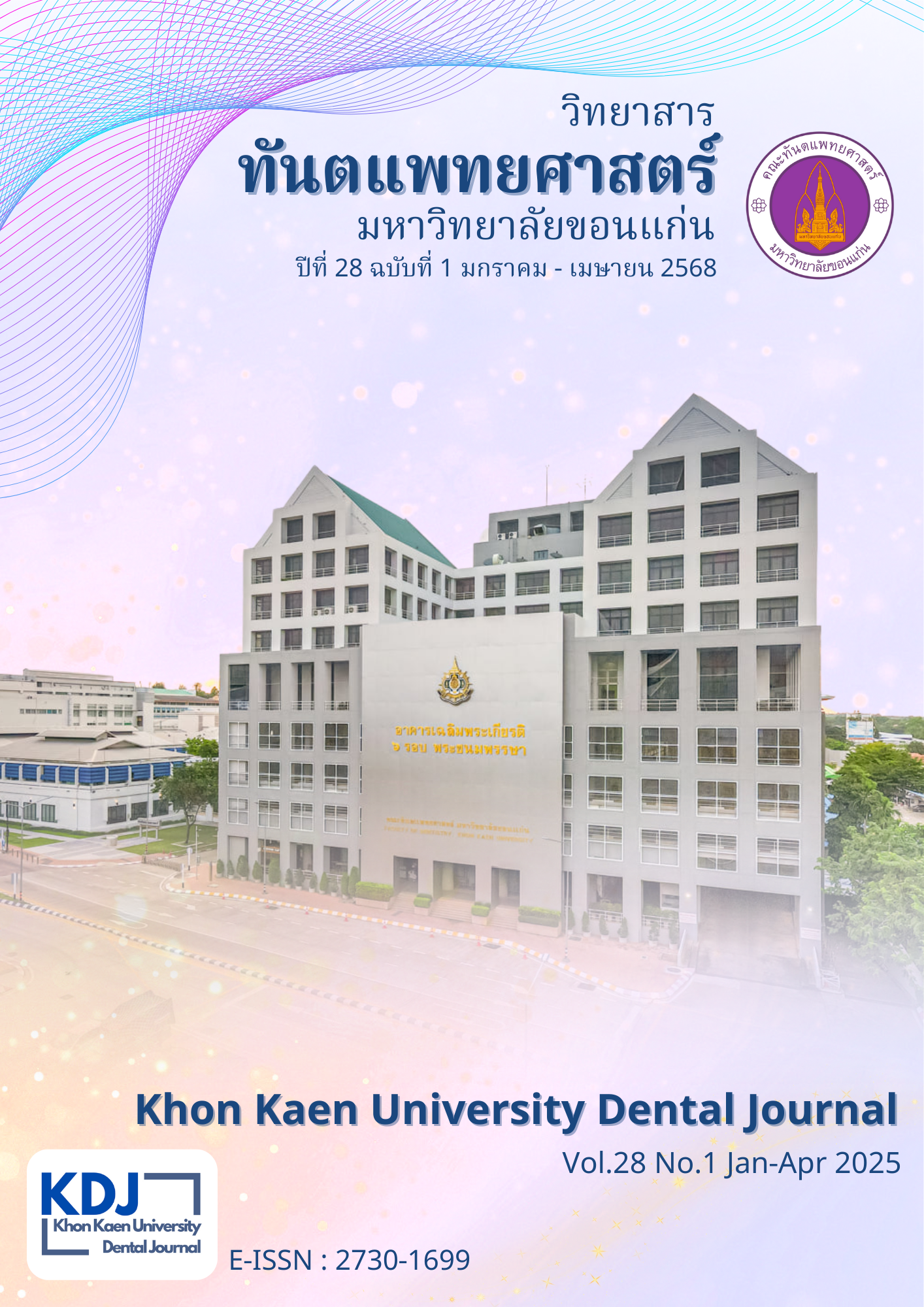The Effect of Disclosing Agent Color Stained on Removable Complete Denture Effect on Perception Among Older People with Visual Impairment
Main Article Content
Abstract
Objective: This study aimed to investigate how different colors of disclosing agents affect the perception of removable complete dentures in older people with visual impairment.
Materials and Methods: The removable dentures were used to create an artificial plaque on both the tissue surface and the artificial tooth side. The red color group (Erythrosin), green color group (Fast green FCF), and blue color group (Brilliant blue FCF) stains were compared to a control group that did not undergo plaque staining. The sample size of this study was 10 older people with visual impairment.
Results: When compared to the control group, there was a statistically significant difference (P<0.05) in the green and blue group plaques' visibility.
Conclusion: A green or blue color group of disclosing agents was recommended for staining on removable complete dentures. As a result of a color group that help older people, it enables individuals with visual impairments to see more clearly and allows for more efficient cleaning of removable complete dentures.
Article Details

This work is licensed under a Creative Commons Attribution-NonCommercial-NoDerivatives 4.0 International License.
บทความ ข้อมูล เนื้อหา รูปภาพ ฯลฯ ที่ได้รับการลงตีพิมพ์ในวิทยาสารทันตแพทยศาสตร์ มหาวิทยาลัยขอนแก่นถือเป็นลิขสิทธิ์เฉพาะของคณะทันตแพทยศาสตร์ มหาวิทยาลัยขอนแก่น หากบุคคลหรือหน่วยงานใดต้องการนำทั้งหมดหรือส่วนหนึ่งส่วนใดไปเผยแพร่ต่อหรือเพื่อกระทำการใด ๆ จะต้องได้รับอนุญาตเป็นลายลักษณ์อักษร จากคณะทันตแพทยศาสตร์ มหาวิทยาลัยขอนแก่นก่อนเท่านั้น
References
Ministry of social development and human security. The act on the elderly 2003. Office of the council of state; 2003.1-14.
National statistical office. The 2021 survey of the older persons in Thailand. Statistical forecasting division, National statistical office; 2022.11-29.
United nations population fund and HelpAge international. Ageing in the twenty-first century: A celebration and a challenge. United nations population fund and HelpAge international; 2012.9-15.
Who.int [homepage on the Internet]. Blindness and vision impairment: World health organization [updated 2022 Oct 13; cited 2020 Apr 11]. Available from: https://www.who.int/news-room/fact-sheets/ detail/blindness-and-visual-impairment.
Bourne RR, Flaxman SR, Braithwaite T, Cicinelli MV, Das A, Jonas JB, et al. Magnitude, temporal trends, and projections of the global prevalence of blindness and distance and near Vision Impairment: a systematic review and meta-analysis. Lancet Glob Health. 2017;5(9):888-9.
Department of empowerment of persons with disabilities, Ministry of social development and human security. Persons with disabilities empowerment act B.E. 2550 (2007). National office for empowerment of persons with disabilities;2007.3-24.
Steinmetz JD, Bourne RR, Briant PS, Flaxman SR, Taylor HR, Jonas JB, et al. Causes of blindness and vision impairment in 2020 and trends over 30 years, and prevalence of avoidable blindness in relation to Vision 2020: The right to sight: an analysis for the global burden of disease study. Lancet Glob Health. 2021;9(2):144-60.
Burton MJ, Ramke J, Marques AP, Bourne RR, Congdon N, Jones I, et al. The lancet global health commission on global eye health: vision beyond 2020. Lancet Glob Health. 2021;9(4):489-551.
Budtz-Jörgensen E. The significance of candida albicans in denture stomatitis. Eur J Oral Sci. 1974;82(2):151–90.
Gendreau L, Loewy ZG. Epidemiology and etiology of denture stomatitis. J Prosthodont. 2011;20(4):251–60.
Souza RF, Regis RR, Nascimento C, Paranhos HF, Silva CH. Domestic use of a disclosing solution for denture hygiene: A randomised trial. Gerodontology. 2009;27(3):193–8.
Bell ML, Whitehead AL, Julious SA. Guidance for using pilot studies to inform the design of intervention trials with continuous outcomes. Clin Epidemiol. 2018(10):153-57.
Whitehead AL, Julious SA, Cooper CL, Campbell MJ. Estimating the sample size for a pilot randomised trial to minimise the overall trial sample size for the external pilot and main trial for a continuous outcome variable. Stat Methods in Med Res. 2016;25(3):1057-73.
Worachotekamjorn K, Chudet S, Singsamart S. Innovations of plaque disclosing in dental care. Center for continuing Pharmacy education. [serial on the internet]. 2020 Apr [cited 2020 Apr 28]. Available from: https://ccpe. pharmacycouncil. org/ index.php?option=article_detail&subpage=article_detail&id=535.
Zoya C, Ranjana M, Vandana S, Rohit R, Aruna D. Disclosing agents in periodontics: an update. J Dent Coll Azamgarh. 2015(1):103-10.
Datta D, Kumar R, Narayanan A, Selvamary L, Sujatha A. Disclosing solutions used in dentistry. World J Pharm Res. 2017(1):1648–56.
Yokoyama S, Tanaka Y, Kojima T, Horai R, Kato Y, Nakamura H, et al. Age-related changes of color visual acuity in normal eyes. PLOS ONE. 2021;16(11):e0260525.
Schneck ME, Haegerstrom-Portnoy G, Lott LA, Brabyn JA. Comparison of panel D-15 tests in a large older population. Optometry Vision Sci. 2014;91(3):284–90.
Aroonmanakun W. The science of language: origin and development. Department of Linguistics, Faculty of Arts, Chulalongkorn University; 2023.
Periobasics.com [homepage on the Internet]. Plaque disclosing agents. [updated 2023 Feb 2; cited 2023 Feb 2]. Available from: https:// periobasics.com/plaque-disclosing-agents.
Tan AE, Wade AB. The role of visual feedback by a disclosing agent in plaque control. J Clin Periodontol. 1980;7(2):140–8.
Sasidharan S, P Rahmath MP. Review on professionally applied disclosing agents. Int J Commun Dent. 2021;9(2)104–6.


